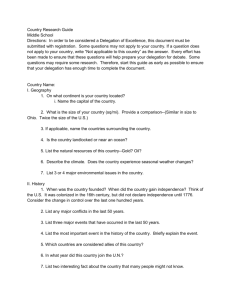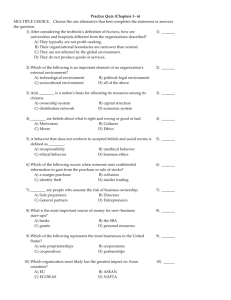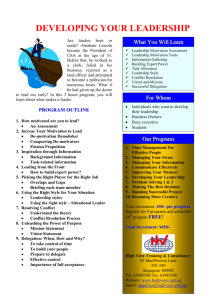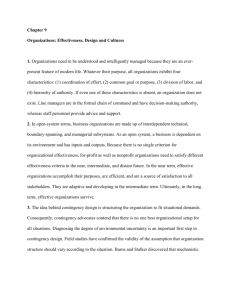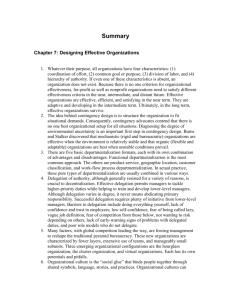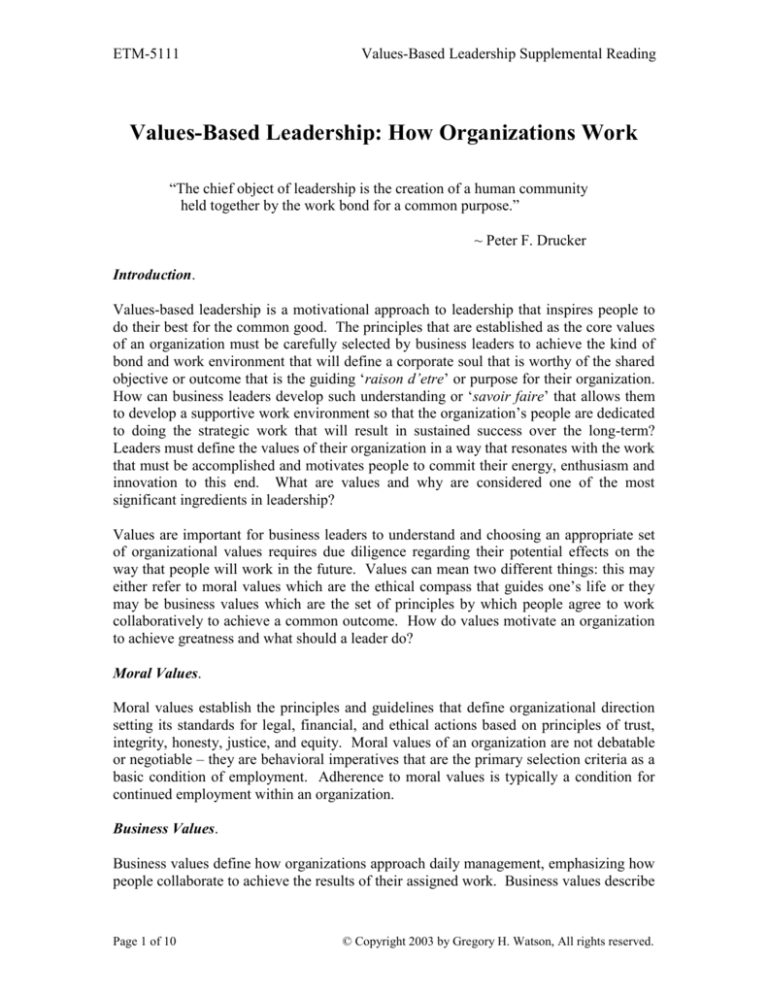
ETM-5111
Values-Based Leadership Supplemental Reading
Values-Based Leadership: How Organizations Work
“The chief object of leadership is the creation of a human community
held together by the work bond for a common purpose.”
~ Peter F. Drucker
Introduction.
Values-based leadership is a motivational approach to leadership that inspires people to
do their best for the common good. The principles that are established as the core values
of an organization must be carefully selected by business leaders to achieve the kind of
bond and work environment that will define a corporate soul that is worthy of the shared
objective or outcome that is the guiding ‘raison d’etre’ or purpose for their organization.
How can business leaders develop such understanding or ‘savoir faire’ that allows them
to develop a supportive work environment so that the organization’s people are dedicated
to doing the strategic work that will result in sustained success over the long-term?
Leaders must define the values of their organization in a way that resonates with the work
that must be accomplished and motivates people to commit their energy, enthusiasm and
innovation to this end. What are values and why are considered one of the most
significant ingredients in leadership?
Values are important for business leaders to understand and choosing an appropriate set
of organizational values requires due diligence regarding their potential effects on the
way that people will work in the future. Values can mean two different things: this may
either refer to moral values which are the ethical compass that guides one’s life or they
may be business values which are the set of principles by which people agree to work
collaboratively to achieve a common outcome. How do values motivate an organization
to achieve greatness and what should a leader do?
Moral Values.
Moral values establish the principles and guidelines that define organizational direction
setting its standards for legal, financial, and ethical actions based on principles of trust,
integrity, honesty, justice, and equity. Moral values of an organization are not debatable
or negotiable – they are behavioral imperatives that are the primary selection criteria as a
basic condition of employment. Adherence to moral values is typically a condition for
continued employment within an organization.
Business Values.
Business values define how organizations approach daily management, emphasizing how
people collaborate to achieve the results of their assigned work. Business values describe
Page 1 of 10
© Copyright 2003 by Gregory H. Watson, All rights reserved.
ETM-5111
Values-Based Leadership Supplemental Reading
the way that work is done in an organization and the behavioral norms that people ascribe
to while working for a specific organization. Business values are a way to operationally
define an organization’s culture. The components of business values include decisions
about how an organization will treat its employees, service its customers, work with its
suppliers, communicate with the public and manage its work processes. There are three
categories of business values:
People-related Values: This class of values describes how people should act
toward each other, respecting the human context of working together. Values
in this category include: respect individuals, delegate decision-making to the
right person, involve all people affected by a decision in the process, etc.
Decision-related Values: This class of values refers to the considerations that
are important when making important decisions within an organization. Some
of the specific values related to decision-making include: put our customers
first, do what makes sense, manage by facts, etc.
Action-related Values: This class of values identifies how an organization
approaches systemic and process-related change. Examples of this value are:
continuously improve our processes and products, beat our best competitor,
achieve leadership among the industry leaders, etc.
Business values are subject to adaptation according to unique social and cultural contexts.
Business values must be reinforced through the role model behavior of an organization’s
business leaders. If business leaders do not themselves act in congruence with the value
system that they advocate, then there is little hope that the organization will take them in
a serious way about applying these values in the work environment. One job of business
leaders is to create a supportive work environment that reinforces values and encourages
their application in order to accomplish the organization’s strategic work.
Supportive Work Environment.
When business and moral values are combined in a working environment to achieve the
vision, strategic intent, or business purpose of an organization, then that combination can
become a supportive work environment when these elements are combined with an open
communication process. A supportive work environment is essential to achieving longterm, consistent achievement of organizational objectives. What does an exceptional
organization do to bind its people into an effective operating unit that achieves its ends?
The elements of a supportive work environment include:
People who are informed about the objectives of the organization, the reasons
or rational for the objectives as well as the timing or priority of each objective;
Participative decision-making in the business decisions that affect employees,
but this does not mean delegation of decision rights – it means inclusion in the
presentation of ideas and alternatives as well as the interpretation of how to go
about achieving the desired outcomes and the results of their efforts;
Climate for open discussion of plans as well as the inclusion of employees in
developing implementation actions so the employee involvement transfers the
ownership for execution from the planner to the doers; and
Page 2 of 10
© Copyright 2003 by Gregory H. Watson, All rights reserved.
ETM-5111
Values-Based Leadership Supplemental Reading
Development of personal attitudes, skill, competence and knowledge so that
all employees can effectively participate in business activities and accomplish
the work they have been assigned.
Graphically, a construct for a supportive work environment could be presented in the
following way:
Elements of a supportive work environment:
Informed about objectives
(what, why, how)
Effective
Communication
and
Feedback
System
Managing the
Strategic Work of People
In an
Exceptional
Organization
Provided Adequate
Skill and Knowledge
Through Training and
Exposure to New Ideas
Participation
in those
Decisions that
Affect them
Climate for Better
Understanding
And Personal
Ownership of
Corporate Plans
Informed about results
(how much, why, when)
Notice that the supportive work environment is focused on the achievement of strategic
work that people perform – work that moves it toward its long-term objectives. How is
strategic work defined?
Elements of Strategic Work.
Strategic work moves an organization forward in its commercial value proposition: where
is it adding value that its customers consider to be “worth-what-they-paid-for-it?” But,
strategic work is much more. Certainly, it contributes value to customers, but it is also
work that is valued by the organization and which the performers of the work also have a
great deal of personal satisfaction. An example may help to understand what is strategic
work and what is not. Consider how many organizations manage their customer service
activities: they staff them with temporary workers who don’t receive much training (e.g.,
call center operators who work on contract), don’t provide them with all the elements of a
supportive work environment (e.g., the desire to take personal ownership for achievement
of objectives due to dissatisfaction with some of the hygiene aspects of their job that they
personally feel are needed in their work infrastructure (like the same level of benefits that
are given to regular employees), and don’t provide them with any delegated authority to
resolve customer problems – just referring customers to others who must take deliver the
Page 3 of 10
© Copyright 2003 by Gregory H. Watson, All rights reserved.
ETM-5111
Values-Based Leadership Supplemental Reading
resolution of their concerns). Strategic work can only be achieved when the people who
do the work feel that they operate in a supportive work environment – lead by committed
managers who assure they have the right skills to do their work and provide a strong
support infrastructure that allows the promises made at their customer touch point to be
fulfilled by the organization in a timely and effective manner.
Characteristics of strategic work:
Valued by Customers
Personally Satisfying
Valued by Organization
Enablers of Success:
• Management Commitment
• Skilled People
• Strong Support Infrastructure
The conduct of strategic work in a supportive work environment fulfills only one element
of an organization’s external outreach. The second element of an organization’s external
outreach is the way that it fulfills its Corporate Social Responsibility (CSR).
Values and Corporate Social Responsibility.
Organizations do not work in a vacuum isolated from society – rather organizations they
actually perform a very important role in society by taking on tasks that are too complex
or long-term to be achieved by individuals. The corporate form of governance was
established to achieve exactly this effect. How does corporate governance assure that the
objectives of society are met? Consider history that describes how the American form of
corporate governance was established – this gives the historical intent for the CSR of
today’s business leaders.
After the American revolution of 1776, the United States Federal government transferred
to state legislatures the power to control “crown corporations” – the group of companies
established by the King of England (e.g., such as the Hudson's Bay Company and the
East India Trading Company). The states defined the purpose of a corporation through
the charter that it issued (also called a certificate of incorporation). In exchange for the
charter, a corporation was obligated to obey the laws, serve the common good, and cause
Page 4 of 10
© Copyright 2003 by Gregory H. Watson, All rights reserved.
ETM-5111
Values-Based Leadership Supplemental Reading
no harm. Early state legislators wrote charter laws and actual charters to limit corporate
authority, and to ensure that when a corporation caused harm, they could revoke its
charter. The responsibility for establishing the framework and authority of corporations
was exercised by the legislative branch of government, not by the judiciary or executive
branches. This had an effect of maintaining close oversight of the corporation by the
public’s duly elected representatives who tended to keep a tight hold on corporations by
spelling out rules each business must follow, holding business owners liable for harms or
injuries, and revoking charters when there was noncompliance with their stated terms and
conditions.
Throughout the 1800s, under pressure from industrialists and bankers, the judiciary
branch gave corporations greater leeway and more rights than the founding fathers had
originally anticipated. Perhaps the most significant ruling came in 1886 when the US
Supreme Court ruled in Santa Clara county v. Southern Pacific Railroad (118 U.S. 394
(1886)) that a private corporation was a "natural person" under the US Constitution,
sheltered by the 14th Amendment, which requires due process in the criminal prosecution
of “persons.” According to the record Supreme Court Justice Morrison R. Waite made
the following business-changing decision:
“The court does not wish to hear argument on the question whether the provision
in the Fourteenth Amendment to the Constitution, which forbids a State to deny to
any person within its jurisdiction the equal protection of the laws, applies to these
corporations. We are all of opinion that it does.” He also stated: “The defendant
Corporations are persons within the intent of the clause in section 1 of the
Fourteenth Amendment to the Constitution of the United States, which forbids a
State to deny to any person within its jurisdiction equal protection of the laws.”
Once corporations were legally defined as “natural persons”, they automatically were
endowed with the same “Bill of Rights” as human beings, and thus came to possess and
exercise the same rights of those granted to individuals by the constitution.
Prior to this point in time (the mid-1800s) corporations had limited duration (10 to 30
years) and were restricted in terms of their business purpose, amount of land that could be
owned and their level of capitalization. In these corporations the sharing of power was in
favor of the shareholders where unanimous consent could be required for some of the
largest shareholder decisions, such as a merger. In addition, there was no limitation to
protect the liability of the corporation – managers, directors, and shareholders were all
held personally liable for all debts of the corporation and in some states, doubly or triply
liable for any damages caused by the corporation. Further, the states reserved the right of
review and the ability to either amend or revoke the corporate charter – in some instances
not even requiring a reason for this action.
Today’s model for governing a corporation is very different: In a speech presented to the
Stern Graduate School of Business of New York University on March 26, 2002, Alan
Greenspan, Chairman of the Federal Reserve Bank, made the following observations
about corporate governance:
Page 5 of 10
© Copyright 2003 by Gregory H. Watson, All rights reserved.
ETM-5111
Values-Based Leadership Supplemental Reading
“Generally speaking, the resulting structure of business incentives, reporting, and
accountability has served us well. We could not have achieved our current level
of national productivity if corporate governance had been deeply flawed.”
“Thus, it has increasingly fallen to corporate officers, especially the chief
executive officer, to guide the business, hopefully in what he or she perceives to
be in the best interests of shareholders. Indeed, the boards of directors appointed
by shareholders are in the overwhelming majority of cases chosen from the slate
proposed by the CEO [Chief Executive Officer]. The CEO sets the organization’s
business strategy and strongly influences the choice of the accounting practices
that measure the ongoing degree of success or failure of that strategy. Outside
auditors are generally chosen by the CEO or by an audit committee of CEOchosen directors. Shareholders usually perfunctorily affirm such choices.”
“To be sure, a CEO can maintain control over corporate governance only so long
as companies are not demonstrably in difficulty. When companies do run into
trouble, the carte blanche granted CEOs by shareholders is withdrawn. Existing
shareholders, or successful hostile bidders for the corporation, usually then
displace the board of directors and the CEO. Such changes in corporate
leadership have been relatively rare but, more often than not, have contributed to
a more-effective allocation of corporate capital.”
Greenspan has succinctly described the current management situation for corporations
and has laid a foundation to discuss how business leaders exercise their CSR and develop
a system of governance for the effective and efficient management of the corporation in
order to deliver value to customers on behalf of owners (or shareholders), not the state
legislatures, as the new dominant external force in corporate governance.
The Role of Leadership.
How do business leaders create synergy that is essential for collaborative strategic work?
Creation of a corporate culture able to adaptively regulate itself toward achievement of its
business objectives is a critical differentiator in a competitive market. This culture is one
that can make numerous organic corrective actions – at each point of human contact with
the customer – just because the entire organization is aligned to the same value system in
the way it approaches work. Thus, decisions affecting customers can be made in a way
that is aligned to the strategic direction of the whole organization – but this effect can
only occur if a supportive work environment has be created by the management team.
How is a values-based supportive work environment established?
First, management must determine the values that it wishes the organization to embrace.
In development of this set of values it is important the frequent and open communication
is made with employees so they can participate in its formulation and expression (it is not
essential that employees choose the values to emphasize – although there is a small set of
value categories that typically are addressed (people-related values reflecting primary
Page 6 of 10
© Copyright 2003 by Gregory H. Watson, All rights reserved.
ETM-5111
Values-Based Leadership Supplemental Reading
stakeholders such as customers, shareholders and employees, as well as specific decisionmaking and action-related values (see definition of value above). This choice by the top
management team defines how the value development cycle will evolve. The values that
are defined and reinforced over the long-term by business leaders will define the attitudes
of employees about how to work. In turn attitudes will influence employee behavior and
through the combined effect of everyone’s appropriate behavior a culture is born that will
reinforce the values. Two critical ingredients for success in the values development cycle
are the choice of appropriate values and the congruent action by management that is in
consonance with these values. If management espouses one set of values and then acts in
a way that is incongruent to these words, then the organization will detect their hypocrisy
and reject the values that are spoken, following instead the values that are lived as the
dominant form of expressing values.
Values development cycle:
VALUES
Culture reinforces values.
CULTURE
Values define attitudes.
Connecting
People
ATTITUDES
Attitudes influence behavior.
Behavior creates culture.
BEHAVIOR
Management must be the role model of its desired behaviors
to create a pervasive, self-perpetuating business culture.
For values to be integrated throughout the organization, it is essential that the whole
organization be not only informed about the value system but also that each individual
internalize these values into their behavioral patterns for working together on behalf of
customers. Business leaders must determine how to connect their human resources in a
way that achieves its strategic work. Values are the glue that ties the organization
together. Two ingredients that facilitate the internalization of values are line-of-sight and
delegation of authority which help transfer ownership for results from the ivory tower of
a corporate office to the front-line of the customer engagement.
Line of Sight, Delegation of Authority and Consensus Management.
Leaders encourage others to achieve organizational objectives and use management tools
like line-of-sight and delegation of decision right authority to engage the full power of the
Page 7 of 10
© Copyright 2003 by Gregory H. Watson, All rights reserved.
ETM-5111
Values-Based Leadership Supplemental Reading
organization in achieving its purpose.
Line of Sight: Line of sight (LOS) is the operating concept that develops
clarity in setting and cascading objectives to action in an organization. LOS is
achieved when the top management can clearly understand how its strategic
direction and business policy has been deployed to the organization’s frontline for action and the people in the front line understand how their work
contributes to the achievement of the organization’s strategic direction and its
strategic work. In Japanese firms LOS is achieved through their planning
system for management by policy or policy deployment (deploying the policy
of the top management throughout the business control system) – this is called
hoshin kanri in Japanese (hoshin refers to the strategic policy of a business
while kanri refers to the control system).
Delegation of Decision Right Authority: When top management delegates its
decision authority to the organization it holds the owner of that authority
responsible for the outcome (quality) of their work. This means that the
recipient is accountable for the results. But, what does this mean? For
business leaders delegation makes the best use of the talents of others who
report to them. Delegation is not about dividing the work of managing into
small parcels and assigning “the leader’s” work to helpers in order to enable
them to take on more work. Delegation assists and empowers others to do
their own work more effectively by relinquishing commensurate authority for
decisions or resource management and removing obstacles that impede the
effective achievement of objectives for those who work with you. Delegation
multiplies the assets of a manager – it does not consolidate them. It does not
direct the work of others, but defines a process by setting a direction,
assigning the charter for work, as well as scheduling and coordinating the
work that others perform. Delegation does not assign work and providing
detailed instructions, rather delegation insures the achievement of objectives
by assists others in completing an assigned task using their own methods.
Delegation does not dictate as an autocrat or dictator – rather it provides
constructive criticism as a coach or mentor. When a person accepts delegated
authority they also accept the responsibility for achieving the results.
Consensus Management: When an organization hires good people, it should
expect these people to have strong beliefs and opinions about what should be
done in order to accomplish the organization’s objectives. Strong performers
develop their own view of the world and it is essential that everyone has an
opportunity to participate in an open dialog and civil debate to express these
views and interpret the facts from their perspective. An organization only will
become stronger when all viewpoints and approaches are considered.
Consensus management is not a democratic form of management where
people vote on actions. Consensus follows more the approach described by
Brian Fisher, an ExxonMobil executive who viewed this as “democratic
discussion followed by autocratic execution” where everybody has the right to
Page 8 of 10
© Copyright 2003 by Gregory H. Watson, All rights reserved.
ETM-5111
Values-Based Leadership Supplemental Reading
present their theory (theory opinion – or “Theory O”) followed by an analysis
of the facts and a management decision when there is no clear interpretation
of the facts that were aired and alternatives explored. However, a consensus
also means that once the discussion is over and a decision is made, then the
whole organization aligns to support that decision and works energetically to
achieve its accomplishment.
Authority, Responsibility and Accountability.
Once authority for decision-making and action has been delegated then the person who
has taken on this authority becomes responsible for the outcome. However, there is a set
of three necessary and sufficient conditions that must be met before an individual can be
held accountable for the quality of their work. All of these three conditions must also be
met in the following sequence in order for them to operate:
Defined expectations: Employees must have clear knowledge about the
expectations of management – people must have good knowledge of the work
they should accomplish and proper preparation in right way to perform work
procedures (effective training) as well as the resources needed to get the job
done (resources refers to material, equipment, information and time).
Capability to perform: People must have knowledge of the standard of
performance that they are being asked to attain and an objective measurement
system must be in place to assure that the data is being collected objectively to
evaluate this performance and provide the necessary knowledge required to
operate the work process so people can effectively and efficiently address the
set of expectations (and thereby assume the delegated responsibility).
Ability to self-regulate their own work: People must have the ability to
observe the work process measures and to make decisions about corrective
action in order to keep their process operating according to the standard when
they are not going to meet the original expectations for desired performance
targets (and thereby exercise their delegated authority to manage within the
limitations of control that has been granted to them).
When these conditions are met, then an individual may be appropriately held accountable
for the quality of their work – this includes the board’s initial delegation of authority to a
CEO as well as the CEO’s delegation of authority down into the organizational system of
management (authority delegation is cascaded, with prescribed limitations, in accordance
with the tree diagram structure of its organization chart). [Delegation diagrams may be
constructed using a decision tree format as one way to assure clarity in expectations for
the limitations of the decision and fiduciary authority that has been entrusted to different
levels of a firm.] The effective delegation of authority and appropriate accountability for
work are key elements of sound business management and allow individuals to selfregulate their work to achieve line-of-sight to the vision. Thus, an organization’s vision
is more than a wish, hope or prayer for its future – it is the catalyst that stimulates action
to achieve alignment of its resources.
Page 9 of 10
© Copyright 2003 by Gregory H. Watson, All rights reserved.
ETM-5111
Values-Based Leadership Supplemental Reading
Values as a Necessary Catalyst for Vision.
Strategic action requires the persistence of a vision over the long-term. Thus a business
vision is a long-term view or perspective of an organization’ path forward – what it hopes
to accomplish through the combined actions of its people. Vision motivates by defining
strategic intent – the reason for people combining their life energies to take on a task that
is greater than any one could hope to achieve on their own. Values are a catalyst that are
necessary for an organization to achieve the “what” of the vision by defining the “how”
people can best collaborate to achieve the results for their mutual benefit.
By creating a values-based leadership system, executives enable their ability to achieve
an over-arching vision for their organization. Vision without values is an empty dream.
Vision supported by incongruent values leads to frustration. But, vision supported by the
synergistic values leads to an energized and enthusiastic work environment where
everyone offers their best work to the sacrifice that is required to achieve their mutual
objective. Such a bond formed by a community experience about a common purpose is
one thing that makes life worthwhile.
Measurement as the Yardstick of Success
Business management systems cannot achieve a vision without measuring progress along
its path forward. Thus, the measurement system and the goal that defines achievement of
the desired end state must be linked to the actions of the work force that are accomplished
on a daily basis to assure that progress facilitates the organizational objective rather than
frustrates it by misalignment of action or sub-optimization of work – a misappropriation
of resources on actions that do not correspond to the strategic direction or supply daily
sustenance needed to accomplish today’s work (also a part of any strategy). The role of a
business measurement system should be to measure profitability in the short-term as well
as strength in the long-term. To accomplish this objective the measurement system must
be capable of representing a balanced perspective for all organizational stakeholders and
at the same time align the goals and working objectives of the organization. Two current
methods for achieving this alignment are through the balanced scorecard approach and
the formation of Six Sigma customer dashboards.
Conclusion
The so-called “soft” decisions of business leaders – establishing the business vision,
values, goals and metrics are all essential ingredients to the recipe for long-term success.
The definition of these ingredients must be a priority in order to build an organization
that will last.
Page 10 of 10
reserved.
© Copyright 2003 by Gregory H. Watson, All rights


